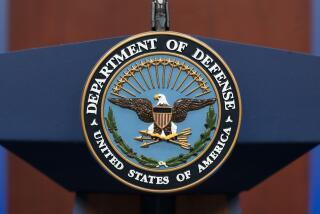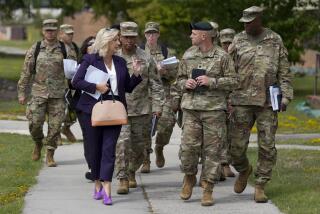Army Plans to Reorganize, Not Expand, to Meet Combat Needs
WASHINGTON â Army Secretary Francis J. Harvey said Thursday that the Pentagon had no plans to ask Congress to permanently increase the size of the Army, saying that the service, strained by the wars in Iraq and Afghanistan, would be able to boost the number of available combat troops by reorganizing from within.
Congress last year authorized a temporary increase of 30,000 troops in the Army, and senior military leaders suggested in recent months that they may try to make the increase permanent to help relieve the stress on the service.
The Army has carried the heaviest burden since the Sept. 11 terrorist attacks.
But Harvey said that by 2011, the Army plans to return to its previous troop level of 482,000 soldiers, barring another significant military commitment abroad.
Many in Congress have supported a permanent expansion for the Army. But Defense Secretary Donald H. Rumsfeld has long opposed an increase, in part because of the cost. The Pentagon estimates that permanently enlarging the Army by 30,000 would cost approximately $3 billion annually.
One result of the decision, Army officials said, was that the Army would not be shortening combat tours served by soldiers in Iraq and Afghanistan. Generals had hoped to shorten the yearlong deployments, citing the effect of 12-month tours on military families.
But Harvey said that the Army had decided to keep the length of combat deployments at 12 months. Keeping units deployed longer, Army officials said, allows the service greater flexibility to reorganize stateside units and to create 43 combat brigades -- up from the Armyâs current total of 37.
âWeâve found this deployment time to be the optimum, and we donât have any plans to change from it,â Harvey said.
In a wide-ranging interview with reporters, Harvey outlined his plan for increasing the number of combat forces available for overseas deployments by converting noncombat jobs into frontline slots.
Harvey said that his plan to avoid requesting more troops from Congress depended in part on the service overcoming current recruiting woes.
The Army was nearly 7,000 recruits short of its active duty goal of 80,000 new troops for the 2005 fiscal year, which ended Sept. 30. Recruiters are finding it increasingly difficult to sell potential candidates on the benefits of military life in the middle of a prolonged war.
Harvey said he envisioned another tough recruiting year in 2006, yet dismissed as âopinionâ the comments made this year by Maj. Gen. Michael D. Rochelle, then the head of the Army Recruiting Command, that the recruiting mission would be more difficult in fiscal 2006 than it was in 2005.
âI think itâs going to be a tough year, but I donât see it as being any tougher than â05,â Harvey said. âWeâve got the same factors influencing the marketplace.â
This week, Harvey announced that the Army would ease recruiting standards by admitting larger numbers of high school dropouts and recruits who scored near the bottom of military aptitude tests.
On Thursday, the Army secretary said that performance on the Defense Departmentâs aptitude tests, known as the Armed Services Vocational Aptitude Battery, was not necessarily a good indicator of whether a recruit would succeed in the Army. Harvey cited Army survey data indicating that 12% of the serviceâs command sergeant majors -- the senior enlisted soldiers in Army units -- scored between the 16th and 30th percentiles of the aptitude tests. âNobody ever questions the caliber of our command sergeant majors,â Harvey said.
A low score on the aptitude tests, he said, âdoesnât necessarily mean that when you get into the Army, youâre not going to have a good career and you are not going to advance.â
âThis Army knows how to train people,â he said.
More to Read
Sign up for Essential California
The most important California stories and recommendations in your inbox every morning.
You may occasionally receive promotional content from the Los Angeles Times.










